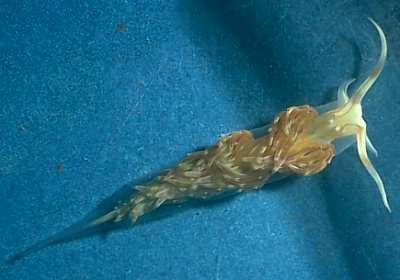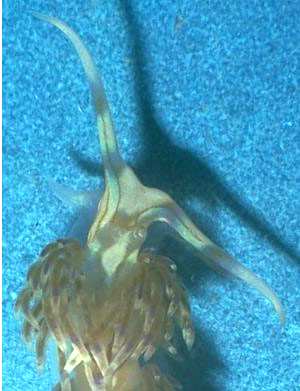

Godiva rachelae
Rudman, 1980
Order: NUDIBRANCHIA
Suborder: AEOLIDINA
Family: Glaucidae
DISTRIBUTION
Probably has a wide Indo-West Pacific distribution. Known from Tanzania and Queensland, Australia.
PHOTO
North Reef (Sewer pipe), Dar es Salaam, Tanzania. 27 September. 1976, 30mm long alive. PHOTO: W.B. Rudman.
The head of the animal is a watery orange with fine deeper orange speckling and a pair of bright orange lines on each side of the head. The area between each pair of lines is milky yellow. The proximal half of the oral tenatacle is a pinkish-purple, except for a patch of millky yellow on the dorsal side. The distal half of the oral tentacle is milky yellow. On each side, from just behind the oral tentacles, a band of milky yellow runs below the cerata to the posterior end of the body. Between each ceratal arch, this yellow band widens. The rest of the body is a pale, watery orange, with a series of markings down the dorsal mid-line. The rhinophores are a watery orange colour with a yellow tip. The foot is translucent white with white patches. The leading edge of the foot and foot corners are milky yellow, and the distal half of the tail is a watery purple. The lower two thirds of the ceratal wall is watery orange. The upper third is transparent, apart from the band of milky yellow just below the tip. The digestive gland appears reddish orange or brownish where masked by the orange ceratal wall, but is a reddish or pinkish purple in the transparent section, the distal part of the digestive gland being a particularly intense purple.
Body elongate and high, growing to at least 37mm long. The rhinophores are long and tapering, appearing slightly wrinkled and annulate in one specimen but smooth in the other two. The oral tentacles are long and slender. The foot is a little wider than the body and at the anterior end the foot corners are long and tapered. The cerata are arranged in 5-7 clusters down each side of the body, each cluster consisting of a multi-rowed arch of cerata on a slightly raised pad. When disturbed, the cerata are held erect, standing 12mm high on a 30mm long animal. At times the animal will swim by lateral flexion of the body.
Egg masses were laid in the aquarium on large hydroid colonies. They form a large, tangled tubular chain of segments containing white eggs. Each segment is approx. 3mm long. Animal was found on the hydroid Eudendrium cf. carneum.
Godiva rachelae agrees in all features with the type-species of the genus, Godiva quadricolor. It differs from that species in colour and in the detailed shape of the radular teeth.
References:
• Rudman, W.B. (1980). Opisthobranch molluscs (Glaucidae) from the Indian Ocean and the south-west Pacific. Zoological Journal of the Linnean Society 68(2), 139-172.
Rudman, W.B., 2002 (February 14) Godiva rachelae Rudman, 1980. [In] Sea Slug Forum. Australian Museum, Sydney. Available from http://www.seaslugforum.net/factsheet/godirach
Related messages
-
Godiva quadricolor? from sthn Queensland
From: Gary Cobb, July 20, 2006 -
Godiva rachelae from Tanzania
From: Bill Rudman, February 15, 2002
